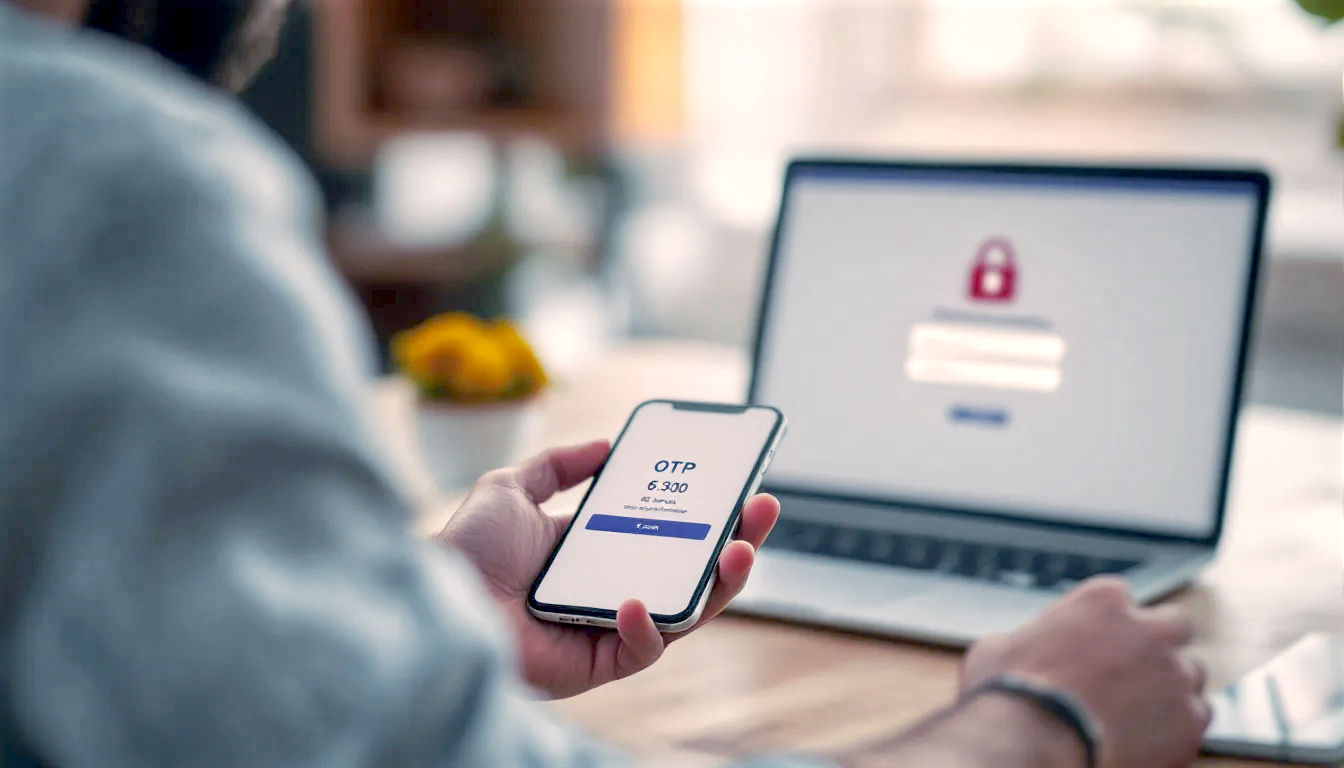The Guide to One-Time Passwords (OTP): How They Keep You Safe Online
Your complete guide to One-Time Passwords (OTPs). Discover how they work, the different types (SMS vs. apps), and how to use them to keep your data safe.

This post may contain affiliate links. If you make a purchase through these links, we may earn a commission at no additional cost to you.
Ever had that little moment of panic? You’ve put your password into a website, and for a split second, you wonder, “What if someone else has this?” In a world where we do everything from our weekly shop to managing our life savings online, that’s a scary thought. A simple password, even a clever one with your dog’s name spelled backward and a few numbers, often isn’t enough to keep the bad guys out.
That’s where a clever little invention called the One-Time Password, or OTP, comes in.
Think of it like this: your normal password is like the key to your front door. It works every single day. But an OTP is like a special ticket for a concert that’s only valid for one entry, right now. Once you use it, it’s useless. This simple but powerful idea has quietly become one of the most important tools keeping our digital lives safe. From logging into your online banking with NatWest to confirming a payment on Amazon or even accessing your records on the NHS app, these little codes are everywhere.
But what exactly are they? How do they magically appear on your phone at the exact moment you need them? Are they all the same? And most importantly, can you trust them to protect your most sensitive information?
This guide will answer all those questions and more. We’ll journey from the early days of computer security to the clever tech in your pocket. We’ll break down how OTPs work without getting bogged down in jargon, explore their strengths and weaknesses, and give you practical tips to use them like a pro. By the end, you’ll not only understand what OTPs are but also appreciate the vital role they play in keeping you safe in our very British, very digital world.
What on Earth Is a One-Time Password?
Let’s start with the basics. A One-Time Password is exactly what it says on the tin: a password that is valid for only one login session or transaction.
Your regular password—the one you use for your email or your favourite shopping site—is a static password. It stays the same until you decide to change it. You can use it today, tomorrow, and next year. An OTP, on the other hand, is dynamic. It changes every single time you need it.
Think of it as the secret knock for a clubhouse. The knock changes every minute. If you don’t know the new knock, you can’t get in, even if you knew the old one.
These passwords are a core part of something called Two-Factor Authentication (2FA) or Multi-Factor Authentication (MFA). This is a security method that requires you to provide two or more different types of proof to verify your identity. It’s based on the principle of:
- Something you know: Your regular password or a PIN.
- Something you have: Your phone, a special key fob, or a USB stick.
- Something you are: Your fingerprint, face, or voice (this is known as biometrics).
An OTP usually falls into the “something you have” category, because it’s generated on or sent to a device you own, like your mobile phone. When you log in, you first enter your password (something you know), and then the website asks for the OTP from your phone (something you have). A hacker in another country might have guessed your password, but unless they’ve also nicked your phone, they can’t get that second piece of the puzzle. It’s this extra layer that makes your account so much more secure.
A Simple Analogy: Your Bank Card and PIN
The easiest way to understand this is to think about your bank card.
When you go to a cash machine, you need two things: your physical bank card (something you have) and your four-digit PIN (something you know).
You wouldn’t dream of a system where you could just walk up and say your PIN aloud to get cash. And a stranger who finds your card on the street can’t use it without the PIN. It’s the combination of the two that proves it’s really you.
OTPs bring that same logic to the online world. Your password is the PIN, and the device that receives the OTP is your digital bank card.
How Do OTPs Actually Work? The Magic Behind the Numbers
So, how does your bank or Google know the exact same random-looking six-digit number that your phone is showing at that very moment? It’s not magic—it’s just very clever maths.
There are two main ways OTPs are created and checked. They are both based on a secret key that is shared between the company (like your bank) and your device (like your phone) when you first set up the system. Think of this secret key as the unique, hidden ingredient in a recipe that only you and the chef know.
1. Time-Based One-Time Passwords (TOTP)
This is the most common type of OTP you’ll see today, used by apps like Google Authenticator, Microsoft Authenticator, and countless others. It’s the one where you see a new six-digit code that refreshes every 30 or 60 seconds.
Here’s a simplified breakdown of how it works:
- The Setup: When you enable 2FA on a service, it generates a secret key. You usually add this to your authenticator app by scanning a QR code. That QR code contains the secret key, which is then stored securely inside the app on your phone. The company’s server also saves this same secret key, linking it to your account. Now, both you and the server share a secret.
- The Clock: Both the server and your phone’s authenticator app know the current time.
- The Algorithm: Every 30 seconds, both your app and the server take two ingredients: the shared secret key and the current time (rounded to the nearest 30 seconds). They feed these into a standard, secure mathematical formula (an algorithm).
- The Magic Code: Because both sides use the same secret key and the same time, the algorithm produces the exact same six-digit code.
When you type that code into the website, the server does its own calculation and checks if your code matches its code. If it does, you’re in! A minute later, the time changes, and the whole process creates a brand-new code. The old one is now completely useless.
This is why it’s crucial that your phone’s clock is accurate. If it’s a few minutes out, the codes won’t match, and you’ll be locked out.
2. HMAC-Based One-Time Passwords (HOTP)
This type is a bit older and less common for logins, but it’s still used, especially for transactions. The “H” stands for HMAC, which is a type of cryptographic hash, and the key difference is that these codes are event-based, not time-based.
Instead of time, HOTP uses a counter.
- The Setup: Just like with TOTP, you and the server share a secret key. But this time, you also share a counter, which starts at 1.
- The Algorithm: To generate a code, the algorithm combines the secret key and the current counter value (e.g., 1). It crunches the numbers and spits out an OTP.
- The Counter Ticks Over: Once that code is used, the counter on both the server and your device clicks up to the next number (e.g., 2). The next time you need a code, it uses the counter value of 2 to generate it.
This means an HOTP code is valid until it’s used. It doesn’t expire after 30 seconds. You might see this when a company sends you a list of backup codes to use if you lose your phone—each code is based on a counter (code #1, code #2, and so on).
The server has to be a bit cleverer with HOTP. Sometimes, you might generate a code but not use it, so your counter and the server’s counter can get out of sync. To handle this, the server will usually check a few upcoming codes just in case. For example, if it expects code #5, it might also check if the code you entered is #6 or #7, and if it is, it will resync its counter with yours.
The Different Flavours of OTP: From SMS Texts to Fancy Fobs
Not all OTPs are delivered in the same way. You’ve probably come across several different methods, each with its own pros and cons.
SMS and Email OTPs: The Old Faithfuls
This is often the first type of OTP people encounter. You try to log in, and the service sends a text message or an email with a code.
- How it works: The server generates a random code, saves it temporarily, and sends it to your registered phone number or email address. You type it in to complete your login.
- The Good: It’s incredibly simple. Everyone has a phone that can receive texts, and you don’t need to install any special apps. It’s very familiar to people in the UK, as banks like HSBC and Barclays have used it for years for their online banking security.
- The Bad: This is now considered the least secure method of delivering OTPs. Hackers have developed techniques like SIM swapping. This is where a criminal tricks your mobile provider (like EE or Vodafone) into transferring your phone number to a SIM card they control. Once they have your number, they receive your OTPs. They can then reset your passwords and empty your bank accounts. Emails are even worse, as they can be hacked more easily.
- Verdict: Better than nothing, but if you have a choice, avoid using SMS or email for your most important accounts.
Authenticator Apps: The Modern Standard
These are the apps on your smartphone that generate the constantly refreshing TOTP codes we talked about earlier.
- Examples: Google Authenticator, Microsoft Authenticator, Authy, LastPass Authenticator.
- How it works: You scan a QR code to link an account. The app then generates TOTP codes entirely on your device. It doesn’t need an internet connection or even a phone signal to work, as all the calculations happen offline.
- The Good: Much more secure than SMS. Because the code is generated on your device and never transmitted to you, it can’t be intercepted by a SIM-swapping attack. Many apps also let you back up your secret keys to the cloud, so you don’t lose access if you get a new phone. Apps like Authy are particularly good at this.
- The Bad: The initial setup can feel a bit fiddly if you’re not used to it. And if you lose your phone without having backups, recovering all your accounts can be a massive headache. You might have to go through lengthy identity verification processes for each service.
- Verdict: This is the gold standard for most people. Secure, convenient, and widely supported.
Push Notifications: The Tap-to-Approve Method
Many apps are now moving to an even simpler system. Instead of making you type in a six-digit code, they just send a notification to your phone.
- Examples: Microsoft Authenticator, Google prompts, banking apps like Monzo and Starling.
- How it works: When you log in on your laptop, a notification pops up on your phone saying, “Are you trying to sign in?” It might show you the location and the time. You simply tap “Approve” or “Deny.”
- The Good: It’s the easiest and fastest method. There are no codes to read and type, which reduces the chance of errors. It also provides more context (like location), which can help you spot a fraudulent attempt.
- The Bad: It relies on you having a good internet connection on your phone. It can also lead to “MFA fatigue,” where hackers repeatedly send login requests, hoping you’ll get annoyed and just tap “Approve” to make them stop.
- Verdict: Excellent for convenience and security, but be vigilant and never approve a request you didn’t initiate.
Hardware Tokens: The Super-Secure Option
For those needing the highest level of security, there are physical devices dedicated to generating OTPs.
- Examples: YubiKey, RSA SecurID fobs.
- How it works: These come in a few forms. Some are small key fobs with a tiny screen that displays a new TOTP code every minute, just like an authenticator app but on a separate device. Others are USB sticks (like a YubiKey) that you plug into your computer and tap. They either type the password for you or use even more advanced cryptographic methods (like FIDO2/WebAuthn).
- The Good: Extremely secure. They are immune to online attacks like phishing and malware because the secret key never leaves the physical device. Since they aren’t your phone, a SIM swap attack is useless. They are often required for high-security jobs, like in government or finance.
- The Bad: They cost money—a YubiKey can be around £40-£50. You also have to carry it with you, and if you lose it, you’ll need a backup.
- Verdict: The best security you can get. Overkill for your local library account, but a very wise investment for protecting your primary email, password manager, or cryptocurrency assets.
A Brief History of the OTP: From Cold War Secrets to Your Tesco Login
The idea of a password that changes every time isn’t new. It has its roots in the secretive world of military espionage.
During the Cold War, spies used one-time pads for sending encrypted messages. A one-time pad was a notepad where each page contained a random secret key. To send a message, the spy would encrypt it using the key on the first page, send the message, and then destroy that page. The receiver had an identical pad and would use their first page to decrypt it before destroying it too. Since the key was used only once and then destroyed, the code was mathematically unbreakable if used correctly.
The digital OTP is the modern descendant of this concept. The core idea—a secret that is used once and then discarded—remains the same.
The transition to the digital world began in the 1980s. As businesses started to connect their computers, they needed better security than simple passwords. A company called RSA (named after its founders Rivest, Shamir, and Adleman—all legends in cryptography) pioneered the first commercial hardware token, the SecurID. In 1986, they released a small fob that displayed a new code every minute. It worked on the same time-based principle as modern authenticator apps.
For years, these tokens were expensive and used almost exclusively by large corporations to protect their corporate networks. You’d see City of London bankers and IT administrators with them attached to their lanyards.
The real revolution came with the smartphone. Suddenly, almost everyone was carrying a powerful little computer in their pocket. This made software-based OTPs, like SMS codes and authenticator apps, possible for the masses. Google was a major driver of this shift. After a major hacking incident in 2010, they pushed hard for two-factor authentication for all their users, making Google Authenticator a household name among the tech-savvy.
Now, driven by regulations like the Payment Services Directive (PSD2) in Europe and the UK, which mandates Strong Customer Authentication (SCA) for online payments, OTPs have become a non-negotiable part of our daily digital lives. That text from your bank to approve an online purchase isn’t just a good idea—it’s the law.
The Good, The Bad, and The Ugly: Are OTPs a Perfect Solution?
OTPs have massively improved our collective security, but they aren’t a silver bullet. It’s important to understand both their strengths and their weaknesses.
The Good Bits
- Massively Reduces Risk from Password Breaches: Huge data breaches happen all the time. Websites like “Have I Been Pwned?” show that most of our passwords are probably floating around on the dark web. If a criminal has your password but you have OTP enabled, your password alone is useless to them.
- Protects Against Replay Attacks: A “replay attack” is where a hacker intercepts your login details (including your password) as you send them over a network. With a static password, they can just “replay” those details later to log in as you. An OTP foils this, because by the time they try to use the intercepted code, it has already expired.
- Relatively Easy to Use: While the underlying tech is complex, the user experience is generally simple: get a code, type it in. Push notifications have made it even easier.
The Bad Bits
- Vulnerable to Phishing: This is the biggest weakness. A clever phishing attack can defeat even the best OTP system. Imagine you get a very convincing text message, supposedly from Royal Mail, saying you need to pay a £1.99 fee for a parcel. It links to a fake website that looks identical to the real one. You enter your username and password. Then, it asks for your OTP. You get the real OTP from your bank and type it into the fake site. The criminals’ computer, in real-time, instantly passes all those details to the real Royal Mail site and authorises a payment of £1,999, not £1.99. You just willingly handed over the keys to the kingdom.
- SIM Swapping: As we discussed, SMS-based OTPs are vulnerable to criminals taking over your phone number. This has become a major problem in the UK, with numerous high-profile cases.
- The Hassle Factor: Let’s be honest, it can be a pain. Fumbling for your phone to type in a code when you’re in a hurry is annoying. Losing your phone and being locked out of your accounts is a nightmare. This friction can put some people off using it altogether.
The Ugly Bit: MFA Fatigue
This is a newer and more insidious threat. Hackers with your password will trigger login attempts over and over again, sometimes in the middle of the night, flooding your phone with push notification requests. They hope that you’ll either get confused, get fed up, or tap “Approve” by accident just to make the notifications stop. It’s a psychological attack that preys on our tendency to get annoyed by technology.
Practical Tips for Using OTPs in the UK
Okay, that’s the theory. But how can you use OTPs smartly to protect yourself?
- Enable OTPs Everywhere You Can: Go through your key accounts right now—your main email (this is the most important!), your Amazon account, any social media, and especially your password manager. Almost all decent services offer 2FA now. Turn it on. Use a site like twofactorauth.org to check which of your services support it.
- Use an Authenticator App as Your Default: Ditch SMS OTPs wherever possible. Download a good authenticator app like Microsoft Authenticator or Authy. Microsoft’s is great because it combines TOTP codes and easy push notifications. Authy is excellent because of its seamless multi-device sync and encrypted backups.
- Save Your Backup Codes! When you set up 2FA, nearly every service will give you a list of 8-10 single-use backup codes. Do not skip this step. Save them somewhere safe and offline. Print them out and put them in a drawer with your passport, or save them in a secure, encrypted file. These codes are your get-out-of-jail-free card if you lose your phone.
- Consider a Hardware Key for Your Crown Jewels: For your most critical accounts—like the email that controls all your other password resets—a hardware key like a YubiKey is the best protection money can buy. It makes you almost immune to phishing. It’s a small investment for total peace of mind.
- Be Suspicious of Every Link: The biggest threat is phishing. Never, ever click on a link in an unexpected text or email and enter your details. If you get a message from your bank, don’t use the link. Go to their website directly or open their official app. Remember, no legitimate company will ever call you and ask for an OTP code over the phone.
- Secure Your Mobile Phone: Your phone is now the key to your digital life. Protect it. Use a strong PIN or biometric lock (fingerprint or face ID). Be careful about the apps you install. And contact your mobile provider to see if you can add extra security to your account, like a verbal password, to make a SIM swap harder for criminals.
The Future of Authentication: Are OTPs Here to Stay?
OTPs have served us well, but technology is always moving forward. The future is likely to be passwordless.
The goal is to get rid of the “something you know” factor altogether, as passwords are the weakest link. The FIDO Alliance, a group that includes giants like Google, Apple, and Microsoft, is pushing a new standard called Passkeys.
A passkey uses the same kind of public-key cryptography that secures the entire internet. When you sign up for a service, your device (your phone or laptop) creates two linked keys: a public key that it shares with the website and a private key that is stored securely on your device and never leaves.
To log in, the website sends a challenge to your device. Your device uses its private key to “sign” the challenge and send it back. The website uses your public key to verify the signature. You approve the login using your device’s built-in security—your fingerprint or face.
There are no passwords to remember, steal, or phish. It combines the security of a hardware key with the convenience of a push notification.
Passkeys are already being rolled out across the web. You can use them today on Google, Apple, eBay, and many other services. They represent the next logical step beyond OTPs—a future that is both more secure and less hassle.
However, OTPs won’t disappear overnight. They are deeply embedded in our systems and provide a solid, understandable layer of security that will be needed for years to come. They will continue to be a vital stepping stone as we slowly transition to a truly passwordless world.
For now, the humble one-time password remains one of your best defences in the digital world. It’s the simple, clever guard standing watch over your online life, asking that crucial second question: “Is that really you?” And in doing so, it makes the internet a fundamentally safer place for all of us.
Further Reading
For those interested in diving deeper into the technical standards and security best practices, here are some highly respected resources:
- National Cyber Security Centre (NCSC): The UK’s authority on cyber security provides official guidance on multi-factor authentication for individuals and businesses. Visit NCSC
- FIDO Alliance: The industry body that is developing the future of authentication, including Passkeys. Their website has in-depth information on the technology that will replace passwords. Visit FIDO Alliance
- Have I Been Pwned?: A crucial resource for checking if your email address or password has been exposed in a data breach, run by security expert Troy Hunt. Visit Have I Been Pwned?






